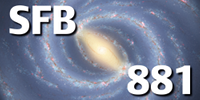Education & Outreach
Educational Activities —
Public Outreach —
Contact
Hier geht's zur SFB 881 - Website
Our main goals are to communicate the fascination and relevance of Galactic astronomy to the general public,
and to support scientists in representing the SFB at meetings and in public.
In particular, we aim at bringing SFB science to a younger audience and informing young people about the associated career opportunities.
Below you will find an overview of activities we participated in and information about ongoing projects:
Educational Activities
Milky Way Kit
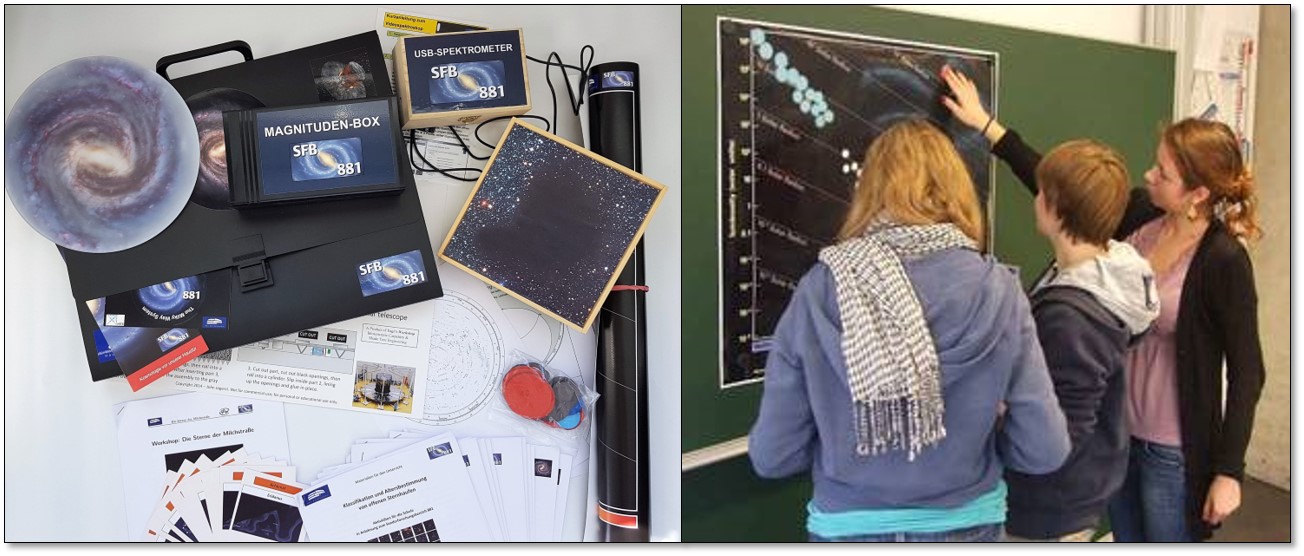
Contents of the Milky Way Kit and students working on the magnetic Hertzsprung-Russell diagram.
We developed the "Milky Way Kit", a collection of hands-on activities aimed at middle school and high school students. The kit features e.g. a magnetic do-it-yourself Hertzsprung-Russell diagram (printed canvas for use on magnetic blackboards), different scale models, activities related to stellar populations, an easy to use USB-spektrometer, as well as a interactive magnitude model.
Workshops
As part of our educational activities we offer workshops, mainly addressed at middle and high school students, available in German and English. They take place at the Haus der Astronomie in Heidelberg and can be attended by any class group. The workshops cover SFB related topics and focus on the stars of the Milky Way, giving an introduction into relevant stellar parameters, star formation and evolution and the Hertzsprung Russel diagram and its implications for astronomy. Additional workshops e.g. on the role of infrared observations for Milky Way astronomy are also available. More information can be found here.
Thesis work for physics teacher students
We also offer supervision of thesis works ("Wissenschaftliche Abschlussarbeit") by physics teacher students at Heidelberg University within the framework of the SFB. The thesis work includes both an scientific part and an educational part, where the produced scientific result is implemented into a school project.
So far three theses works habe been developed within this collaboration:
2012 in relation to the age determination for the metal-poorest stars of the Milky Way (in cooperation with sub-project A4),
2013 with educational material related to the search for open star clusters and its implications for the formation of the galactic disc
(in cooperation with sub-project B5),
and 2015 on the chemical composition of stars in globular clusters (in cooperation with sub-project A8).
All three were co-advised by SFB outreach scientist Cecilia Scorza and SFB members (S. Röser, N. Christlieb, and A. Koch, respectively).
Interested physics teacher students (Lehramtsstudierende Physik an der Universität Heidelberg) are encouraged to contact us if you are interested in a thesis work within the SFB framework.
Gaia Live event
SFB outreach scientist Stefan Jordan at the Gaia Live event 2014
Outreach to schools also includes direct visits by SFB (outreach) scientists to Milky Way Ambassador schools, as well as a very special event related to the Gaia mission: In collaboration with ESA, we organized the German part of a Europe-wide live event for schools, which included a direct link to ESA scientists and engineers working on the Gaia mission. Our local node of this event was attended by 300 pupils between the ages of 15 and 17, and included presentation by Cecilia Scorza and Stefan Jordan s well as by SFB scientist Coryn Bailer-Jones (touching upon sub-projects B5 and B9). The event is an example of a more general fruitful outreach collaboration between our SFB and the outreach team for Gaia-DPAC, the consortium tasked with analysing Gaia data.
Materials for Download
- Workshop: "Die Sterne der Milchstraße"
- Infomaterial Sonderforschungsbereich SFB 881"
Public Outreach
Outreach for the general public is provided in several ways, including public talks, print products, explanatory videos and visualisations, special events and several popular science articles. In the following a short overview about past activities is given:
Public Lectures
Numerous public talks on SFB related topics were given throughout the last years. For instance, the 2017 edition of the popular pubic talk series "Astronomy on a Sunday before noon" was dedicated to SFB research, and consisted of five talks by SFB scientists (Hans-Walter Rix, Sabine Reffert, Rüdiger Pakmor, Andreas Just, Ralf Klessen) related to various subprojects. More information about the series can be found here.
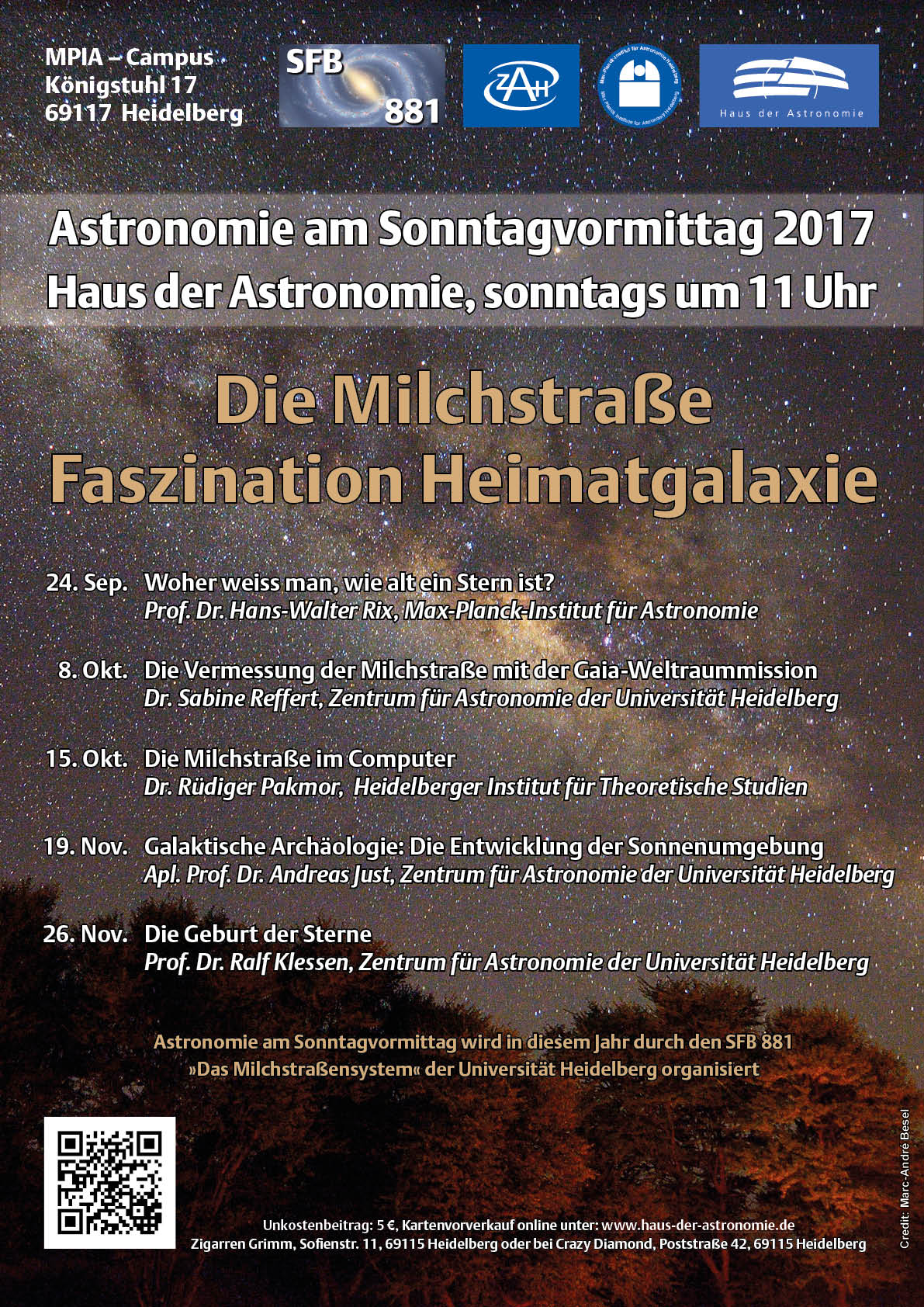
SFB 881 edition of the "Astronomy on a Sunday
before noon" popular science talk series
Additional talks by SFB scientists were given at the university anniversary talk series "Universum für alle" in 2012, and continuously at the popular "Fascination Astronomy" series at the Haus der Astronomie. An overview about the talks can be found below.
- Mai 2012: Hans-Walter Rix (A1, A2, A3), Die Entstehung der Milchstraße
- Juli 2012: Andreas Quirrenbach (A9), Die größten Teleskope der Welt
- August 2012: Eva Grebel (A2), Galaktische Archäologie
- November 2012: Thomas Henning (B7), Astrophysik im Labor - Über Fußballmoleküle, Nanodiamanten und Sternenstaub
- Januar 2013: Volker Springel (A1, A6, B1), Astrophysik mit dem Supercomputer
- September 2013: Ralf Klessen (B1, B2), Die turbulente Geburt der Sterne
- Dezember 2013: Thorsten Lisker, Die bewegte Geschichte kleiner Galaxien
- Oktober 2014: Andreas Koch (A8), Die Entstehung der Milchstraße und ihrer Geschwister
- April 2015: Siegfried Röser (B5), Offene Sternhaufen
- Juli 2016: Derek Homeier (A4), Der Stoff aus dem die Sterne sind - was Spektroskopie über Zusammensetzung und Herkunft der Himmelskörper verrät
- November 2016: Volker Springel (A1, A6, B1), Das Universum im Supercomputer
- Februar 2017: Stefan Jordan (Z1), Die Vermessung der Milchstraße - die ersten Daten des Astrometriesatelliten Gaia
- März 2017: Hendrik Beuther (B1), Himmelsdurchmusterungen - Interstellare Materie in neuem Licht
- Mai 2017: Friedrich Röpke (A10), Supernovae vom Typ Ia
- April 2017: Daniel Rahner (B2), Was macht ein Stern, wenn wir nicht hinschauen?
Talks highlighting the space mission Gaia, the produced data and its importance for galactic astronomy and SFB science are given frequently by SFB outreach PI Apl.Prof. Dr. Stefan Jordan. A list of his talks can be found here.
Print Materials
Several popular science articles have been published in Germany's most popular astronomy magazine Sterne und Weltraum:
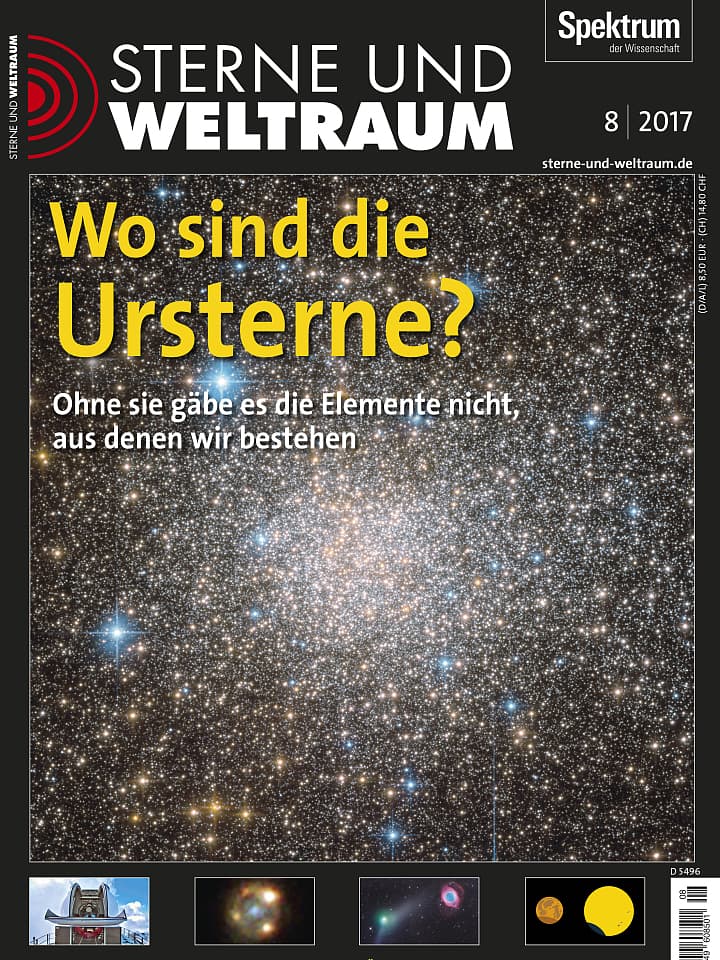
Sterne und Weltraum cover from August 2017,
referencing the lead article written by N. Christlieb.
- SuW 1/2014: Eva Grebel (A2, A3, A5, A8, A9): Zwerggalaxien - Trabanten der Milchstraße
- SuW 3/2014: Hendrik Beuther (B1): Wie aus Gas und Staub Sterne entstehen
- SuW 9/2014: Hans-Walter Rix (A1, A2, A3): Die Sternenscheibe unserer Milchstraße
- SuW 9/2014 und SuW 11/2015: Stefan Jordan (Z1): Gaia - Die räumliche Struktur unserer Galaxis
- SuW 10/2015: Siegfried Röser (B5): Offene Sternhaufen
- SuW 9/2016: Erik Bertram und Ralf Klessen (B1, B2): Sternentstehung im Computer – Die Rolle der Turbulenz
- SuW 8/2017: Norbert Christlieb (A3, A4, A8, A9) und Hans-Günter Ludwig (A4): Auf der Spur metallarmer Sterne
- SuW 9/2017: Volker Springel (A1, A6, B1): Kosmischer Kode – Supercomputer modellieren die Entstehung des Milchstraßensystems
- SUW 7/2018: Andreas Quirrenbach (A9): 4MOST: Mit Highspeed den Himmel durchmustern
- planned for 2018: Rainer Spurzem (Z2): Supercomputer
In June 2014 SFB PI Prof. Hans-Walter Rix prominently featured in a GEO KOMPAKT edition No. 39, talking about his galactic research.
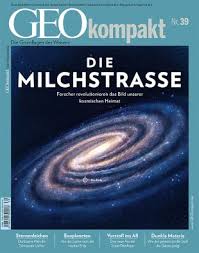
GEO kompakt, edition no 39, featuring SFB
scientist Hans-Walter Rix talking about
his galactic research
Additional articles explaining the Gaia space mission and its importance for galactic science are listed here:
- SuW 5/2013: Ulrich Bastian: Projekt Gaia: die sechsdimensionale Milchstraße. Teil 1: Warum und wozu Gaia gebaut wird
- SuW 6/2013: Ulrich Bastian: Projekt Gaia: die sechsdimensionale Milchstraße. Teil 2: Wo, wann und wie Gaia arbeiten soll
- SuW 3/2016: Ulrich Bastian: Ein Sternhaufen wird zerlegt. Gaia sieht erste Einzelheiten der Milchstraße
- SuW 5/2014: Stefan Jordan (Z1): Gaia in der Testphase
- SuW 11/2015: Stefan Jordan (Z1): Gaia beginnt mit den wissenschaftlichen Messungen
- SuW 10/2016: Ulrich Bastian und Stefan Jordan (Z1): Eine Milliarde Sternpositionen
- Spektrum der Wissenschaft, 6/2017: Stefan Jordan (Z1): Gaias erster Sternkatalog
- Abenteuer Astronomie 14/2018: Stefan Jordan (Z1): Sterne in Bewegung
- SuW 6/2018: Ulrich Bastian & Michael Biermann: Gaia- der zweite Sternkatalog
- SuW 7/2018: Stefan Jordan & Ulrich Bastian Großer Ansturm auf die Gaia-Daten
Special Events
Several special events highlighting the SFB and its research took place in the last years:
- December 2013: Gaia Launch Event, hosted at Haus der Astronomie.
- March 2014: Gaia Live Event, an event aimed at high school students around Heidelberg hosted at the Astronomische Lehrzentrum at Helmholtz Gymnasium in Heidelberg. SFB outreach scientists talked about the Gaia space mission, including a live broadcast to ESA headquarters.
- September 2016: Gaia DR1 Event, press event on the occasion of the first data release of the Gaia space mission.
- June 2016: Participation at the Open Day at Max Planck Institute for Astronomy and Haus der Astronomie.
- May 2017: Participation at the Abenteuer Weltraum Tag at Haus der Astronomie
- December 2017: Official launch of two astrophysics-themed postage stamps (including a Gaia stamp!) by Deutsche Post at Haus der Astronomie
- April 2018: Press event on the occasion of the second Gaia data release, covering up to 1.7 billion stars.
Exhibitions
Currently, a 1-to-10-scaled model of the Gaia satellite and a large infoboard (240 cm times 240 cm) presenting the SFB's central theme of "local cosmology" are traveling Germany as part of the Einstein inside traveling exhibition, a collaboration between numerous institutes supported by BMBF and the WE Heraeus foundation. So far the exhibition was hosted at the following locations:
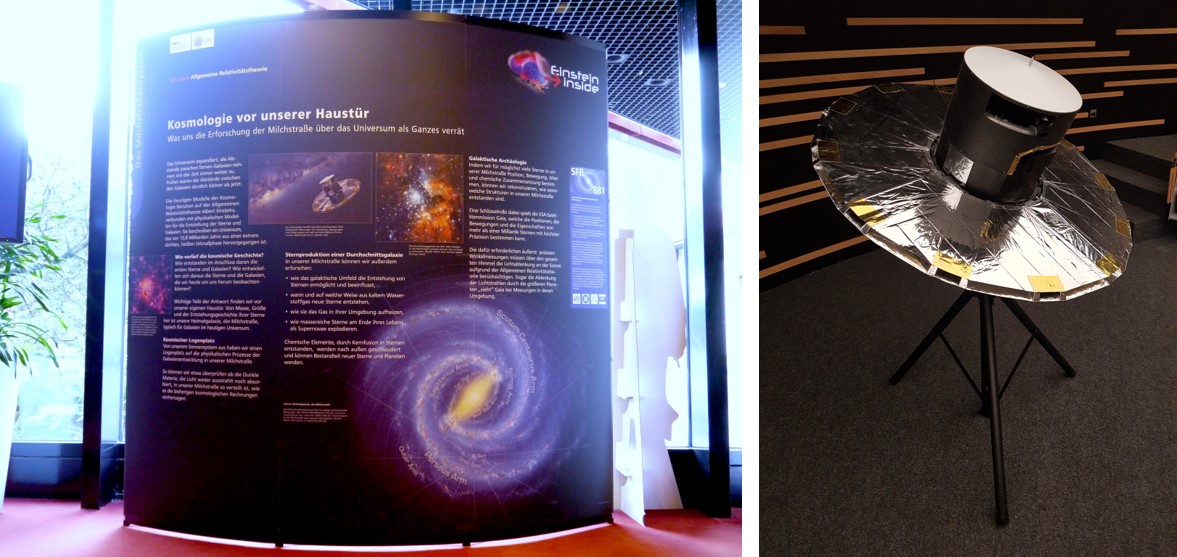
Infoboard and Gaia model currently on tour with the Einstein Inside exhibition
| 26.09.2016 – 04.11.2016 | Kirchhoff-Institut für Physik, Universität Heidelberg |
| 09.11.2016 – 23.12.2016 | Goethe-Universität Frankfurt |
| 11.02.2017 – 23.04.2017 | Didaktikzentrum M!ND, Würzburg |
| 01.09.2017 – 01.11.2017 | Deutsches Museum, Bonn |
| 23.11.2017 – 06.01.2018 | Hochschule für Angewandte Wissenschaften, Hamburg |
| 12.01.2018 – 08.04.2018 | Planetarium Bochum |
| 13.04.2018 - 23.10.2018 | Jahrtausendturm im Elbauenpark Magdeburg |
Additional exhibition elements include a back-lit SFB Milky Way model as part of the permanent exhibition at the European Southern Observatory's new visitor's center and planetarium located in Garching close to Munich, the ESO Supernova.
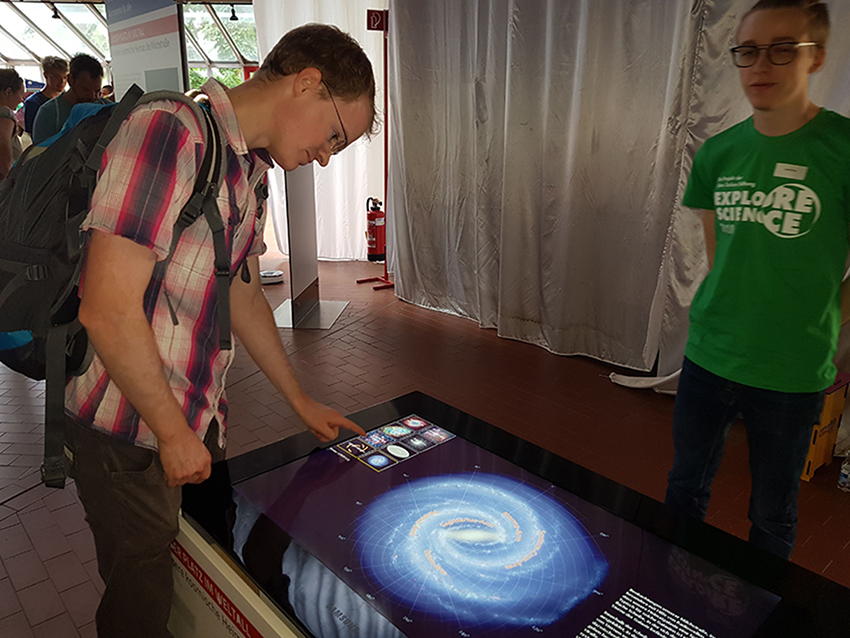
Milky Way touch table at the Explore Science 2018
in Mannheim
In June 2018 SFB content was included in yet another traveling exhibition, the
Explore Science 2018 in Mannheim,
funded by the Klaus Tschira Foundation.
An interactive Touch Table enabling visitors to explore our home Galaxy with the touch of their fingertips was installed at the exhibition, that attracted 52,000 visitors this year.
The exhibition, designed at the Max Planck Institute for Astronomy and the Haus der Astronomie,
both part of the SFB, will become a traveling exhibition after the second Explore Science event in Bremen, later this year.
Hands-on experiments based on the Milky Way Kit were already featured at two large-scale Explore Science family science fair events organized by the
Klaus Tschira Foundation in Luisenpark in Mannheim: In 2012, we presented the astronomical distance measurements central to our knowledge of our
cosmic neighbourhood at the mathematics-themed edition of Explore Science, which was attended by more than 56,000 visitors.
In 2014, we returned to Explore Science with an exhibit about the Milky Way as an environment for habitable planets,
and the variety of planets within our home Galaxy, suitable to that year's theme of biological and environmental diversity,
attracting more than 43,000 visitors.
We also used our exhibits to present the SFB at the national conference of the German astronomical society (AG) in Tübingen in September 2013.
Videos and Visualisations
- Exploring the Universe
The following English and German short films were produced by Dr. Maria Bergemann, the Max-Planck Institute for Astronomy, the SFB 881, the Haus der Astronomie, and the Institute of Astronomy, Cambridge.
- Why am I like a Star? (for kids 6-12) — Warum bin ich wie ein Stern? (für Kinder 6-12 J.)
- What are Stars Made of? (for kids 6-12) — Woraus ist ein Stern gemacht? (für Kinder 6-12 J.)
- Spectroscopy - Splitting the Starlight — Spektroskopie - Sternenlicht zerlegen
- Building a Star from Bits and Bytes — Sterne im Computer
- How to find an Exoplanet — Wie findet man Exoplaneten?
- Cooking up the Chemical Elements — Wie die chemischen Elemente entstanden sind
- Our Galaxy – Milky Way. A big UFO-like Object — Unsere Heimatgalaxie - die Milchstraße. Ein großes UFO-ähnliches Objekt.
- Gaia on Video
Several video documentations and visualizations regarding the Gaia data have been produced in the past:

- Gaia - Teamwork for a billion stars, a 50min production explaining about the Gaia space mission and its implications for astronomy.
- Stellar Parallaxes, an explanation video for Gaia Parallaxes by Stefan Jordan.
- Gaia First Data Release
-
On April 8-10, 2015, 22 members of the Gaia Data Processing and Analysis Consortium DPAC met in Heidelberg to discuss the current status of AGIS,
the Astrometric Global Iterative Solution,
the mathematical procedure that will determine the positions, movements, and distances of about one billion stars from the individual measurements of the Gaia satellite.
Klaus Jäger and Stefan Jordan have produced a 15 minute DPAC outreach video that explains the Gaia mission and its goals. The movie contains interviews with leading Gaia scientists, who explain the challenges behind AGIS and describe how it will finally result in the most accurate star catalogue ever.
The movie is available in German and English. - Gaia Data Release 2: A guide for scientists. This series of 15 videos produced by Klaus Jäger and Stefan Jordan, meant to give some overview of Gaia Data Release 2 and give help or guidance on the usage of the data
- With the data retrieved from the Gaia second data release a number of videos were produced using Gaia Sky Software. A playlist of thes DR2 videos by Stefan Jordan can be found here.
Contact
Dr. Renate Hubele, Astronomisches
Rechen-Institut am Zentrum für Astronomie der Universität
Heidelberg & Haus der
Astronomie
hubele(at)hda-hd.de, Tel. (06221) 528-291
Apl.Prof. Dr. Stefan Jordan, Astronomisches Rechen-Institut am Zentrum für Astronomie der Universität Heidelberg
jordan(at)ari.uni-heidelberg.de, Tel. (06221) 54-1842
Dr. Markus Pössel, Haus der Astronomie
poessel(at)hda-hd.de, Tel. (06221) 528-261


